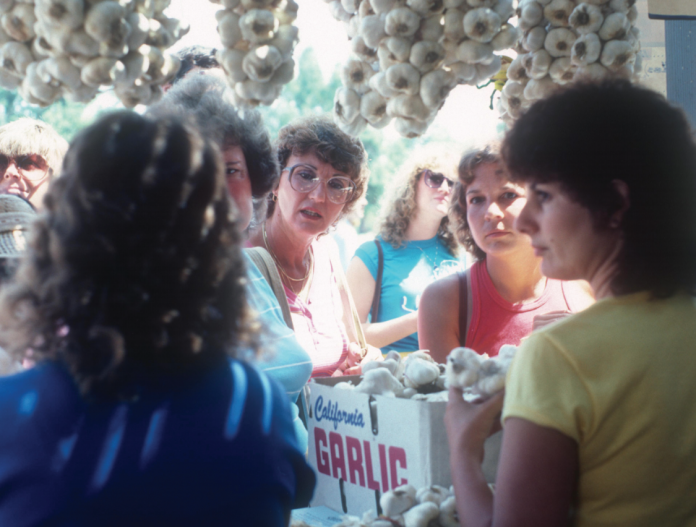There is no evidence that Scottish-born 19th-century seaman John Gilroy ever tasted garlic. But today, especially in Northern California, his name (and his namesake city) is as deeply linked to the famously odiferous herb as peanut butter is to jelly.
You don’t usually think of Gilroy without also thinking of garlic, and vice versa. One word always seems to follow the other. You don’t stand in line between innings at a Giants game at AT&T Park for garlic fries, but for “Gilroy Garlic Fries.”
Maybe it’s those shared g’s and r’s and l’s. Alliteration often gets overlooked in the spread of great ideas. Maybe it was the result of a lot of hard work in the realm of agricultural marketing. Either way, the fusing of “Gilroy” and “garlic” has to be one of the most successful examples of branding between place and product in contemporary American history. The two words dance arm in arm around the world.
With the 40th Gilroy Garlic Festival upon us, maybe it’s a good time to remember that when the festival began, neither Gilroy nor garlic had much of a positive public image at all. The Festival itself has been praised for years for the efficiency, the value and the pure fun of the event itself. But the Garlic Festival also represents a triumph of brand marketing. It has carried the name of the city of Gilroy across the world, and it has completely turned around the reputation of garlic.
Today, garlic is ubiquitous in American cuisine, beloved for its bold and pungent taste and versatility. In the last few decades, nutritional science has even found significant health benefits to eating garlic, making it even more popular. Today, in millions of household kitchens, unlike the 1970s when the festival began, you can find a garlic press, maybe a terra-cotta garlic roaster, and bulbs of fresh garlic.
But garlic was not always the belle of the ball. For most of the 20th century, garlic was ostracized, largely because of its odor but also because it was associated with immigrants from southern Europe, said food anthropologist Pauline Adema, who published the book Garlic Capital of the World: Gilroy, Garlic and the Making of a Festival Foodscape in 2009.
“The early community leaders (in Gilroy) were able to take this thing that had been a big negative, that had been seen as foreign and stinky—‘the other’ as we talk about in anthropological circles—and, partly because of good timing and geographical location, make it a positive.”
The creation story of the Gilroy Garlic Festival is well-known, at least locally. It was the product of a partnership between Gavilan College president Rudy Melone and farmer Don Christopher who, with his brother Art, first began growing garlic in Gilroy in the 1950s. The two were joined by chef and garlic evangelist Val Filice.
Melone died in 1998—his stewardship of the Festival earned him a New York Times obituary. But a year before his death, he told writer Jenny Midtgaard, that “there was a general air of embarrassment about garlic,” at the time of the Festival’s founding.
Melone, Christopher and Filice spearheaded a small group of community leaders, each of whom took on a role crucial in the success of the fledgling festival. Assigned to engage the world outside Gilroy were two women: veteran publicist Caryl Saunders, and Karen Christopher, Don Christopher’s wife (Karen Christopher eventually was divorced from Don Christopher who then married another woman named Karen, so there are two Karen Christophers in the Gilroy garlic story).
In 1978, a year before the first festival, Melone and Don Christopher hosted a Rotary Club event at Christopher Ranch that could be seen as a kind of mini Garlic Festival. Karen Christopher (the first) credits Saunders for inviting several key media figures to that event, including Betsy Balsley, the food editor for the Los Angeles Times who was so charmed by the event, she encouraged Don Christopher to make it an annual event.
Balsley’s enthusiasm was the first indication that Gilroy’s rehabilitation of garlic might play favorably to the world outside.
Karen Christopher sits in her Morgan Hill home, holding an old spiral-bound book. It’s the 1980 California Media book, a resource guide featuring the names and contact information for scores of newspapers, magazines, radio stations and television stations.
“I had never done promotion before,” she said. “I’m not one to think small. I saw this as a larger opportunity for the industry and the community. So I bought this.”
The first Gilroy Garlic Festival had been a small success, and there were media members there to write about it. But the second year, Christopher decided to vault into another realm altogether. She wrote press releases on the festival and sent them out (snail mail only, of course) to media outlets all over California and many around the country. Many of the press releases were printed verbatim in newspapers and periodicals across the country.”
The strategy was simple, to blanket the media with news releases to create a kind of momentum for coverage. She cold-called TV producers, got people booked on talk shows, set up photo shoots and cooking demonstrations. She employed the festival’s secret weapon, the charismatic chef Val Filice who would do radio gigs cooking a few of the festival’s signature dishes in the studio. “The aroma of that garlic would float around the studio,” remembered Christopher, “and the next thing you know, people are walking in the door, trying to figure out what that wonderful smell was. And Val always had enough to give everyone a sample.”
Food festivals were an exciting trend at the time and the image of garlic—the smell, the reputation, all the potentially amazing dishes—proved to be irresistible to the media. Sunset magazine and AAA magazine covered the festival. The Wall Street Journal wrote a feature, which was picked up by its satellite publications around the world. Clever wags couldn’t resist the vampire references: The Great Falls Tribune in Montana headlined its story: Count Dracula Would Not Stay at Gilroy Garlic Festival and Cook-Off.
“Garlic was the easiest product to ever market,” said Christopher. “If you think about it, you have the food angle, the agricultural part of it, the fun aspects—y’know, the ‘vampires are coming to get you!’—the health aspects. There were so many different ways to cover the story, it just blossomed. Once the word got out, it just grew like crazy.”
The first Gilroy Garlic Festival came at a time when the contemporary gourmet food movement was maturing as well, said anthropologist Adema. “What was happening in the Bay Area in the ’60s and ’70s was this food movement expanding. It’s not just (Chez Panisse food icon) Alice Waters—though she just happened to have a garlic dinner a few years earlier—but it was also ‘hippie’ food, that subcategory of foods associated with the counterculture.”
Growing interest in Italian, Greek and Asian cuisines coincided with new ideas about nutrition and there within those overlapping circles stood garlic.
The early success of the Garlic Festival as a magnet for curious out-of-town visitors was an example of cultural trends coming to meet an ambitious outreach effort, backed by a well-organized event.
“I did have some sleepless nights,” said the first Karen Christopher of those days before the first festival. “There was all this busy-ness going on around me. The entertainment was coming together. The food was coming together, the booths. Everyone in the community who were involved were really putting out all kinds of effort. And I thought, ‘Oh my God! If I don’t do my job, nobody’s going to show up.’”
But people did show up. And they haven’t stopped.








